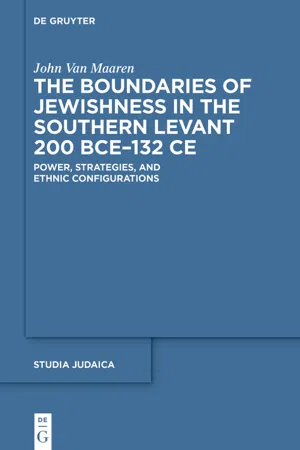The Ancient Jews as an Ethnic Group: A Heuristic Choice
In order to employ the ethnic boundary making model, I approach the ancient Jews as an ethnic group.14 This is not a foreign idea to persons in antiquity, for Greek, Roman, and Jewish authors consistently designate the Jewish people as one ethnos (ἔθνος) among the many ethnē (ἔθνη) residing in the Greek and Roman worlds.15 It is true that the ancient term ethnos is broader than the modern category “ethnic group”16 and can refer to groups of nearly any sort (e.g., bees, doctors, or males).17 Further, not all ancient people groups described as ethnē represent ethnic groups by all definitions of ethnicity (e.g., Syrians).18 However, many, including the ancient Jews, are accurately described by this modern category.19 While various ways of belonging to the Jewish ethnos were emphasized by different persons at distinct times and in separate places, these differences do not change the basic designation of the Jews as an ethnos.20
John Hutchinson and Anthony D. Smith outline six features commonly shared by co-ethnics.21 I quote their definitions here with brief explanations of how these were configured by members of the Jewish ethnos to show that each common characteristic is attested among at least some Jews and that treating Jewishness as an ethnic designation is warranted. I do not think that all six characters are part of the configuration of Jewishness for all Jews in antiquity, nor that all Jews understood each of the following features in the way I summarize below. Rather, these short summaries present common ways that some Jews configured each of these six common features, as indicated by the limited historical data. Throughout the study I italicize references to the names of these six common features.
(1) A common proper name, to identify and express the “essence” of its community.
In antiquity, three attested proper names are associated with the Jewish ethnos: “Hebrew” (ירבע, ’Εβραῖος, Hebraeus), “Israel” (לארשי, ’Ισραήλ, Israhel), and “Jew” (ידוהי, ̓Ιουδαῖος, Iudaeus).22 “Hebrew” primarily designates a person from the pre-monarchic period of Jewish history.23 In second-temple texts, “Israel” can designate members of the united monarchy, northern kingdom, eschatological Israel, or simply function as a timeless designation of the ethnos. As we will see, most of the writers and redactors of the texts we address prefer “Israel.” During our period, the term “Jew” often designates members of the contemporary ethnos, but sometimes it designates a geographically defined subgroup, or specifically descendants of the southern kingdom of Judah. It is also used by the Seleucid, Hasmonean, and Roman rulers.24 Thoughout this study I refer to the ethnic group as “the Jewish ethnos” rather than “Israel.” This is partly for convenience, but it is also meant to reflect official designations of the people group and so take a broad and encompassing perspective.
(2) A myth of common ancestry, a myth rather than a fact, a myth that includes the idea of a common origin in time and place and that gives an ethnie a sense of fictive kinship.
The eponymous ancestor Jacob/Israel is of central importance for Jewish ancestry. As we will see, putative descent from Abraham was employed to expand definitions of Jewishness by the Hasmoneans and contested by others.
(3) Shared historical memories, or better, shared memories of a common past or pasts, including heroes, events, and their commemoration.
The events narrated in Jewish sacred texts provide a foundational collection of historical memories. The communal reading of these texts in synagogues, a practice apparently unique to the Jews in antiquity, further engrained these narratives in collective Jewish identity.25 Prominent figures include the Patriarchs, Moses, David, Ezra, etc. Formative events include the call of Abraham, the exodus from Egypt, the constitution of a covenant people at Mt. Sinai, the golden age of the united monarchy, the exile and deportation to Babylon, the Antiochene persecution, and the Hasmonean rebellion.
(4) One or more elements of common culture, which need not be specified but normally include religion, customs, or language.
Religion, customs, language, and other cultural aspects shared by some Jews overlap significantly. Religion cannot be disentangled from other cultural elements, especially in antiquity.26 While those elements of Jewishness most closely associated with the modern term religion may be the Jewish deity and cultic veneration, both in Jerusalem and at other cultic sites, the observance of specific Jewish customs (e.g., dietary laws, Sabbath observance) is closely associated with Jewish law and with obedience to their deity. Accordingly, this study will approach the Jerusalem temple, cultic practice, and law as part of common culture, without distinguishing religion from common customs. At the same time, this study will retain the term ethno-religion as a subcategory of ethnicity. This designation describes ethnic groups for whom those elements most commonly associated with the modern concept of religion are especially prominent and when the practice of other common customs is reinforced by appeal to an ethnic deity. In the case of the Jewish ethnos, these elements are primarily the Jewish deity and the associated cultic veneration. While there was no single language that was spoken by all Jews, the Hebrew language, as the language of many of their sacred texts, at times functioned symbolically for non-Hebrew speaking Jews.
(5) A link w...
